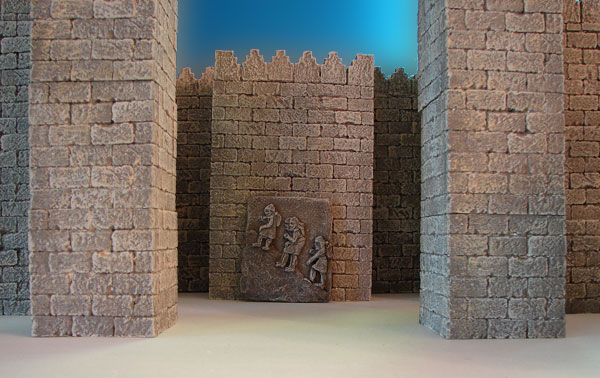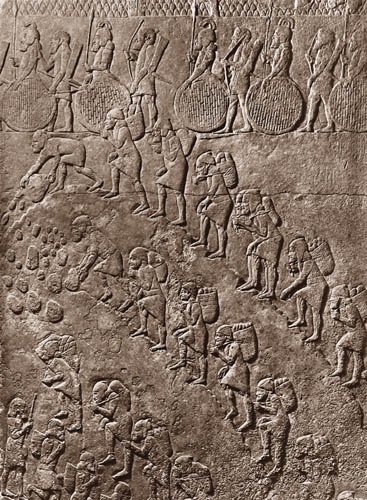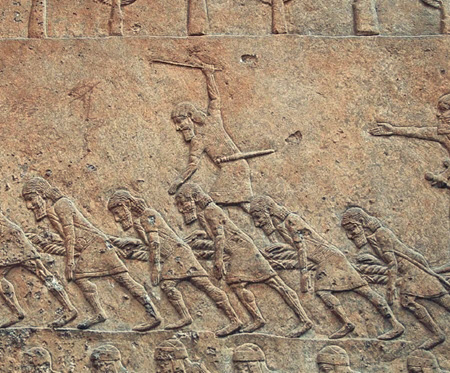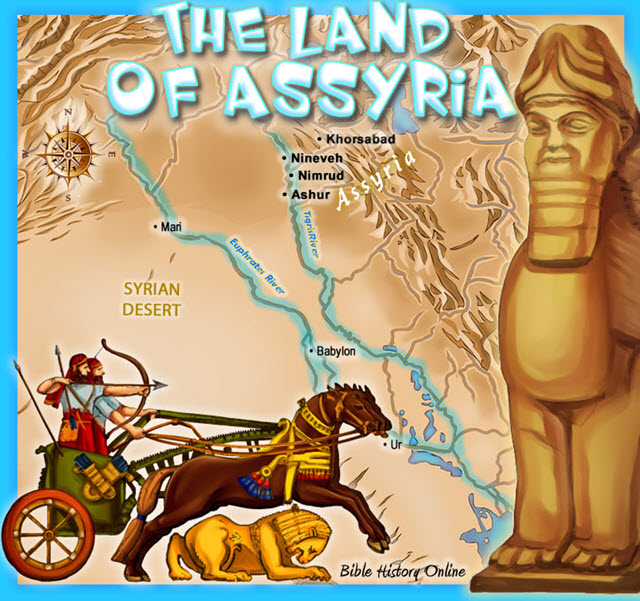|
|
This miniature replica shows three prisoners of war caring heavy loads of rocks in a quarry with many armed guards above. The limestone relief is from the Palace of Sennacherib, king of Assyria at Nineveh his capital. It is from the seventh century BC. The original is located at the British Museum. "For the children of Israel walked in all the sins of Jeroboam which he did; they departed not from them; Until the LORD removed Israel out of his sight, as he had said by all his servants the prophets. So was Israel carried away out of their own land to Assyria" 2 Kings 17:22-23
Museum Images
Information about the Forced Slave Labor Quarry Relief - Alabaster relief from the SW palace of
Sennacherib at Nineveh, his capital. 2 Kings 17:14-17 - "Notwithstanding they would not hear, but hardened their necks, like to the neck of their fathers, that did not believe in the LORD their God. And they rejected his statutes, and his covenant that he made with their fathers, and his testimonies which he testified against them; and they followed vanity, and became vain, and went after the heathen that [were] round about them, [concerning] whom the LORD had charged them, that they should not do like them. And they left all the commandments of the LORD their God, and made them molten images, [even] two calves, and made a grove, and worshipped all the host of heaven, and served Baal. And they caused their sons and their daughters to pass through the fire, and used divination and enchantments, and sold themselves to do evil in the sight of the LORD, to provoke him to anger. Therefore the LORD was very angry with Israel, and removed them out of his sight." Therefore the LORD was very angry with Israel, and removed them from His sight; there was none left but the tribe of Judah alone. . And the LORD rejected all the descendants of Israel, afflicted them, and delivered them into the hand of plunderers, until He had cast them from His sight. For He tore Israel from the house of David, and they made Jeroboam the son of Nebat king. Then Jeroboam drove Israel from following the LORD, and made them commit a great sin. For the children of Israel walked in all the sins of Jeroboam which he did; they did not depart from them, until the LORD removed Israel out of His sight, as He had said by all His servants the prophets. So Israel was carried away from their own land to Assyria, as it is to this day."
Dimensions Note: There is another part of this stone panel at the British Museum that reads: The movement of a stone sculpture from the quarries. This panel continues the narrative from the previous panel in the series that originally decorated two sides of a courtyard at King Sennacherib's palace. Instead of the usual scenes of warfare, they show the transport of a human-headed winged bull, or lamassu, part of Sennacherib's construction work. Here, the lamassu is being levered forward, hauled on its way to Nineveh. Written documents show that Sennacherib took a close interest in the progress of building and decoration; he proudly describes the palace as one 'without rival'. He also made use of senior officials including experts in magic who knew how to position magical guardian figures for maximum protection. Sennacherib planned to transform the ancient city of Nineveh into a place that would astonish the civilized world. A system of canals and stone aqueducts brought water from forty or fifty miles to the parks, orchards and allotments of the city. This relief helps us to reconstruct ancient quarrying and building techniques. The stone was cut with great iron saws, which can be seen being carried by some of the workers on the relief. Examples of such saws have been excavated at Nimrud. The colossal figures (weighing up to sixteen tons) were roughed out to reduce their weight, but the final carving was done after it was set in position, as was done with the carved relief panels.
The first great military empire in ancient history was the Assyrian Empire. By the time of Ashurnasirpal and Shalmaneser III in the 9th century BC the Assyrians organized a mighty army of nearly 200,000 soldiers. Their military strategy was unsurpassed up to that time, and with the age of iron they were an unstoppable fighting machine. They brought spearmen, archers, shieldmen, slingers, siege engines, chariots, and a huge calvary into the battlefield. The mighty Assyrians dominated the ancient world until they were crippled by the God of Israel in the reign of Sennacherib. God raised up the Assyrians to remove Israel out of his sight for their rebellion and idolatry, but the Assyrians would also be punished also for their wicked ways. They finally fell to the Medes and Babylonians in 612 BC and passed into history.
2 Kings 15:29 - In the days of Pekah king of Israel, Tiglath Pileser king of Assyria came and took Ijon, Abel Beth Maacah, Janoah, Kedesh, Hazor, Gilead, and Galilee, all the land of Naphtali; and he carried them captive to Assyria. 2 Kings 15:19 - Pul the king of Assyria came against the land, and Menahem gave Pul one thousand talents of silver, that his hand might be with him to confirm the kingdom in his hand. 2 Kings 18:9 - And it came to pass in the fourth year of king Hezekiah, which [was] the seventh year of Hoshea son of Elah king of Israel, that Shalmaneser king of Assyria came up against Samaria, and besieged it. Isaiah 20:1 - In the year that Tartan came unto Ashdod, when Sargon the king of Assyria sent him,) and fought against Ashdod, and took it; 2 Kings 19:16 - LORD, bow down thine ear, and hear: open, LORD, thine eyes, and see: and hear the words of Sennacherib, which hath sent him to reproach the living God. 2 Kings 19:37 - And it came to pass, as he was worshipping in the house of Nisroch his god, that Adrammelech and Sharezer his sons smote him with the sword: and they escaped into the land of Armenia. And Esarhaddon his son reigned in his stead. Ezra 4:10 - and the rest of the nations whom the great and noble Asnapper brought over, and set in the city of Samaria, and in the rest of the country beyond the River, and so forth, wrote. Assyrian Kings Names in Cuneiform Archaeology of Ancient Assyria Timeline of Ancient Assyrian Kings (During the Period of the Biblical Kings)
Assur-nasirpal II (885-860
B.C.) A cruel warrior king, he made Assyria into the most fierce
fighting machine of ancient world.
For More Info See: Bible History Online
The Assyrian Annals. The scribes of the chief cities of the Assyrians wrote the accounts of the king's military campaigns on cuneiform tablets, and clay prisms or cylinders. The accounts are very reliable, even though the accounts do not speak negatively of the Assyrians and are meant to glorify the king. The annals also give much detail to geography and Chronology. It is interesting how accurate the Assyrians were with dates, they made use of an Assyrian Kings List or the Eponym Canon. The Assyrian Chronicles and Eponym Canon. The Assyrian scribes organized their national events whether military, political or religious every regnal year. The Babylonian Chronicles were structured the same way. Assyrian records were kept very carefully, they took their dating and their history seriously. They attached their record of events with the solar year and with the name of an official who was known as the "limmu." Their was a new limmu appointed every year. They recorded military, political and religious events in every year and made references to eclipses. The Assyrian records are highly dependable and allow Biblical scholars a very accurate way of dating events and designating "eponyms" for 244 year in Hebrew history, from 892-648 BC.
The Assyrian King List.
The Assyrian King List reveals a list of the kings of ancient
Assyria in chronological order, from the 2nd millennium BC to 609 BC. It
lists the name of the king, his father's name, the length of his reign,
and some great achievements. The Bible. The Old Testament records the history of the Kingdoms of Israel and Judah, along with the battles of other nations. It includes the fall of the 10 tribes in northern kingdom of Israel in 722 BC by the Assyrians, as well as the fall of the southern kingdom of Judah in 586 BC by Nebuchadnezzar of Babylon. The Bible also records miraculous events surrounding people like Elijah, and Jonah, as well as the slaying of 185,000 Assyrians at Jerusalem by the Angel of the LORD. The events recorded in 2 Kings generally agree with Assyrian and Babylonian sources. |






